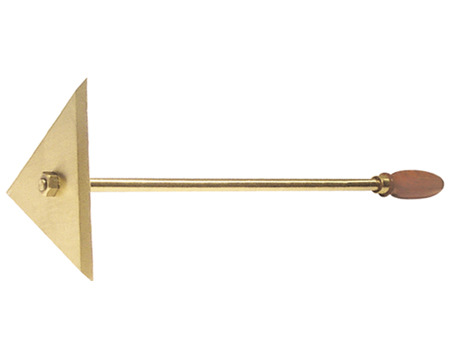Triangle scraper is a kind of scraper tool, which is used in some industries and machinery to improve the accuracy of some parts or beautify their appearance. Generally, we rarely use this kind of tool in life, so most people don't understand the triangle scraper. Let's introduce the manufacturing process of the triangle scraper.
Â

Manufacturing technology of triangle scraper
Â
1. Rough grinding: when rough grinding, stick the two planes of the triangle scraper to the side of the grinding wheel. At the beginning, you should first touch the edge of the grinding wheel, and then slowly lay it flat on the side, and move forward and backward continuously to sharpen so that both sides When it reaches flatness, there is no obvious difference in thickness on the full width of the scraper. Then rough-grind the top surface, place the tip of the scraper on the rim of the grinding wheel and move the blade sharply left and right. The end surface is required to be perpendicular to the center line of the blade body. When grinding, it should first contact the grinding wheel with a certain inclination and then gradually move to the horizontal. If you press the grinding wheel directly in the horizontal position, the triangular scraper should tremble and be difficult to grind, or even an accident will occur.
2. Heat treatment: Put the coarsely ground triangular scraper with a head length of about 25mm, and slowly heat it to 780 ~ 800 ℃ (sakura red) in the fire. After taking it, quickly put it into cold water (or 10% concentration) In brine), cool and immerse to a depth of about 8-10mm. When the scraper touches the water surface, it will slowly translate and move up and down a little bit intermittently, so as not to leave a clear limit on the hardened part. When the part of the blade exposed to the water surface is black, and the blade is white when taken out from the water, the blade is quickly immersed in water to cool until the triangle blade is completely cold and then taken out. After heat treatment, the hardness of the cutting part of the blade should be above HRC60 (Rockwell hardness) for rough scraping. The fine scraper and scraper scraper can be cooled with oil during quenching, the cutter head will not crack, the metal structure is fine, easy to sharpen, and the hardness of the cutting part is close to HRC60.
3. Fine grinding: The scraper after heat treatment should be finely ground on the fine grinding wheel, basically meeting the shape and geometric angle requirements of the scraper. When the blade is sharpened, it must be dipped in water frequently to prevent the blade edge from being annealed.
4. Fine grinding: The fine grinding of the triangle scraper must be carried out on the whetstone. Add proper amount of motor oil to the oilstone during operation, grind the two surfaces until the surface is flat, and the surface roughness Ra <0.2um, then grind the end face carefully, sharpen the left hand to hold the handle, and the right hand firmly hold the blade body, so that the scraper stands upright on the oilstone. Slightly forward (the forward angle is determined by the different wedge angles of the scraper), and the blade body is slightly lifted when pulled back to avoid abrasion of the edge. This is repeated until the shape and angle of the cutting part meet the requirements and the edge is sharp until.
The above is the content of the triangle scraper production process introduced to you. In fact, the treatment process of the triangle scraper is not much different from other scrapers, but pay attention to safety when processing. In the four-step production process of the triangle scraper Every step is critical, so that a good triangular scraper can be made.
Fused Silica windows available uncoated, or with anti-reflection coatings optimized for UV, visible or IR spectrum. Transmission characteristics and thermal properties make Fused Silica windows an excellent choice for most optical applications. Fused Silica windows are often used as vacuum viewports and sight glasses, mirror substrates, wedged windows and many other.
High Precision Applications
Sizes Ranging from 5 to 220mm Diameters
AR coating for laser lines and broadband
UV Fused Silica substrates are available for a variety of UV, Visible and NIR applications.
Fused Silica Window Substrates can be used for multipurpose applications. Purchase optically finished substrates to be coated with an AR coating, highly reflective dielectric or metallic coating.
UV Fused Silica Windows are precision manufactured using UV-grade
synthetic fused silica. In addition to superior transmission, the
synthetic fused silica of these optical windows exhibit higher thermal
properties, exceptional purity, and excellent environmental durability
for demanding applications.
- Available Uncoated or with Broadband Anti-Reflection Coatings
- Ideal for Cost Sensitive Broadband Applications
- Sizes Ranging from 5mm to 100mm Diameter
Fused Silica Windows,UV Fused Silica Wedged window,Drilling Hole Fused Silica Windows
Changchun Ruiqi Optoelectronics Co.,Ltd , https://www.ruiqi-optics.com